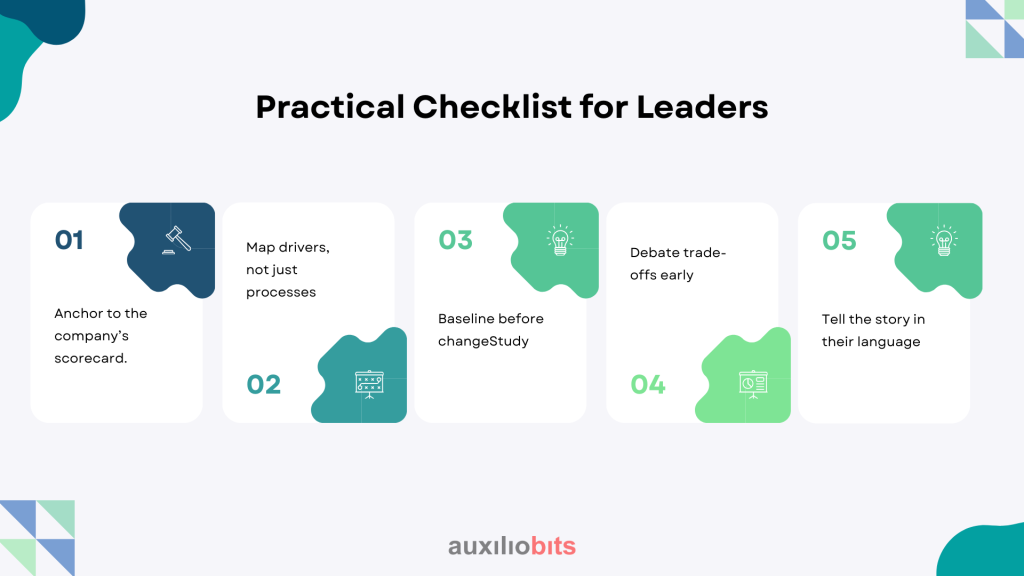
Key Takeaways
- Automation should be KPI-first, not process-first. If a project doesn’t tie to a financial, operational, or experience-related KPI, it will struggle to win lasting sponsorship.
- Quick wins can mislead. Automating “easy” processes may save time, but it often fails to influence strategic bottlenecks that actually matter to leadership.
- Baseline data is non-negotiable. Without clear “before” measurements, any claim of improvement lacks credibility—and risks eroding stakeholder trust.
- Trade-offs are inevitable. Improving one KPI (like cycle time) can harm another (like compliance or satisfaction). Surfacing those conflicts early prevents political headaches later.
- Sometimes automation isn’t the lever. Training, policy enforcement, or process redesign may fix KPI gaps faster than a bot or AI model ever could.
Walk into any quarterly business review, and the story repeats itself. Charts, dashboards, and KPIs fill the screen. Someone inevitably asks, “We invested heavily in automation last year. Why aren’t these numbers moving?” And the answer is rarely about broken code or failed bots. The uncomfortable truth: automation programs often aren’t tied tightly enough to the company’s performance metrics.
Also Read: Combining ML Models with RPA for Intelligent Automation
KPIs as the Only Language That Gets Heard
In theory, automation should make things faster, cheaper, and more reliable. But executives don’t wake up thinking about how many hours were saved or how many scripts went live. They consider operating margin, customer churn, and order cycle time.
An owner said, “I remember sitting with the finance head of a global manufacturing company. Their shared services team had automated invoice data entry. IT showed off glossy slides: “90% touchless processing achieved.” The VP wasn’t impressed. Her reaction? “That’s great, but DPO hasn’t moved. We’re still paying suppliers on the same cycle.”
It was a painful reminder: KPIs, not activity metrics, define success. Efficiency for efficiency’s sake is invisible at the top table.
To keep it concrete, three types of KPIs tend to matter most when connecting automation to business outcomes:
- Financial markers: working capital, revenue leakage, cost-to-serve.
- Operational throughput: error rates, backlog clearance, and cycle times.
- Experience-related measures: NPS, onboarding duration, and first-contact resolution.
If automation isn’t shifting one of these, it risks being filed under “technical housekeeping.”
The Wrong Entry Point: “What Can We Automate Quickly?
Many teams begin their automation journeys with the question, “Which processes are easiest to automate?” On the surface, it sounds smart—quick wins, early proof, momentum. In reality, it’s backward.
Take a European logistics provider. They put six months into automating shipment scheduling. The tool worked. But when the COO reviewed delivery metrics, there was no improvement in the KPI he cared about most: on-time delivery rate. The automation shaved minutes off clerical work but had no bearing on the outcome that mattered.
That’s not to say small wins are worthless. They do build confidence. The problem comes when 80% of the portfolio looks like that—tidying edges instead of tackling bottlenecks.
Starting from the Driver, Not the Process
The smarter move is to ask: What drives the KPI? Then figure out where automation intervenes. Some examples:
KPI: Days Sales Outstanding (DSO)
- Drivers: invoice accuracy, dispute handling, and timely reminders.
- Automation levers: bots validating invoices, automated dunning messages, and ERP-CRM sync.
KPI: First-call resolution in customer support
- Drivers: speed of knowledge retrieval, routing precision.
- Automation levers: AI search assistants, automated call triage.
KPI: On-time supplier delivery
- Drivers: how fast new vendors are onboarded, purchase order approvals, and exception handling.
- Automation levers: document extraction, workflow approvals, and anomaly detection
This is where automation shifts from an isolated IT play into a business lever.
The Seduction of “Quick Wins”
The idea of “low-hanging fruit” has been repeated so often that it’s almost a cliché. Quick wins are useful for building credibility, but they can also create an illusion of progress.
For example, A hospital had proudly automated form entry during patient intake. Clerks saved a few hours each week. IT was thrilled. Yet when leadership checked KPIs, patient wait times—the number they tracked religiously—were unchanged. The true bottleneck wasn’t intake at all, but eligibility verification with insurers. That remained untouched.
So, yes, celebrate quick wins, but don’t confuse them with impact. If the effort doesn’t alter the bottleneck tied to a KPI, it’s not a win in the eyes of leadership.
The Work: Baselines
Here’s another common mistake: skipping baseline measurement. Without baseline data, improvement claims sound like marketing fluff.
One finance director confided in me, “We said we would cut reconciliation efforts by 40%. But honestly, we never tracked the baseline, so when the audit asked, we had nothing.”
Gathering baseline data—cycle times, error rates, handoff delays—takes patience. People often resist it. But without it, you can’t credibly link automation to KPI changes. Worse, you risk losing trust.
KPIs Rarely Line Up Neatly
A complication nobody likes to admit: KPIs often conflict.
- Shortening call handling time looks great for efficiency, but can hurt customer satisfaction.
- Automating invoice approvals speeds payment but might loosen compliance oversight.
- Reducing manual touches in finance increases throughput but risks more disputes later.
No team deliberately undermines another function. But if KPIs aren’t debated upfront, these trade-offs surface only after damage is done. That’s why governance must include cross-functional voices—finance, operations, compliance, and customer experience. Otherwise, automation optimizes for one department at another’s expense.
Governance That Actually Works
Good governance isn’t about extra paperwork. Done right, it forces accountability. A few practices I’ve seen help:
- Every proposal is tied to a KPI. Intake forms demand a specific KPI link.
- Stage gates tied to business impact. Projects don’t scale until KPI evidence is validated.
- Business-language dashboards. Forget “bots deployed.” Show reduced cycle time, lower error rate, and faster cash collection.
When governance is structured this way, automation stops being a scattershot initiative and starts resembling a disciplined investment program.
A Bank That Got It Right
A mid-sized bank had an 80-process backlog in its automation pipeline. Instead of picking based on ease, the COO asked a sharper question: “Which processes directly affect loan approval turnaround, our biggest KPI gap?”
The list narrowed to three: document validation, credit checks, and exception routing. Within half a year, the average loan approval time fell from 12 days to 7. That measurable shift convinced the board to double funding.
The technology wasn’t novel; the prioritization was. Anchoring automation to the bank’s strategic KPI turned it from an “IT project” into a “board-level enabler.”
The Human Side (Often Ignored)
Metrics don’t tell the full story. People do. Automating approvals might slash cycle time but leave managers resentful if they feel bypassed.
A retailer’s call center learned this the hard way. AI assistants cut handle time by 15%. On paper, fantastic. In reality, employee satisfaction scores dropped, attrition climbed, and the net benefit evaporated. The KPI improvement was real—but so was the cultural damage.
Numbers can’t capture every human consequence. And without people buying in, automation gains won’t stick.
Practical Checklist for Leaders
For leaders steering automation strategy, a few grounding steps help:

- Anchor to the company’s scorecard. Pick KPIs the C-suite is already staring at.
- Map drivers, not just processes. Understand what truly influences those KPIs.
- Baseline before change. No shortcuts here—measure the “before” state.
- Debate trade-offs early. Anticipate which KPI gains might erode others.
- Tell the story in their language. “Loan approvals sped up by five days” beats “four bots deployed.”
When Automation Isn’t the Answer
Worth stating plainly: sometimes the right fix isn’t automation at all.A manufacturing CFO once told me, half-jokingly, “We didn’t need bots to fix DSO. We just needed sales to stop handing out discounts without approval.” He was right. Automation is powerful, but it can’t replace discipline, training, or policy. Not every KPI gap is a technology problem.
Final Reflection
Automation is at its best when it’s invisible—when it quietly moves the numbers executives obsess over. If the CFO doesn’t see a margin shift, if the COO doesn’t see throughput improve, if customers don’t feel the difference, then automation hasn’t earned its keep.
The discipline isn’t glamorous: start with the KPI, trace back to the driver, then design automation around it. That’s the only way automation moves from being an IT exercise to a true lever of enterprise performance.








